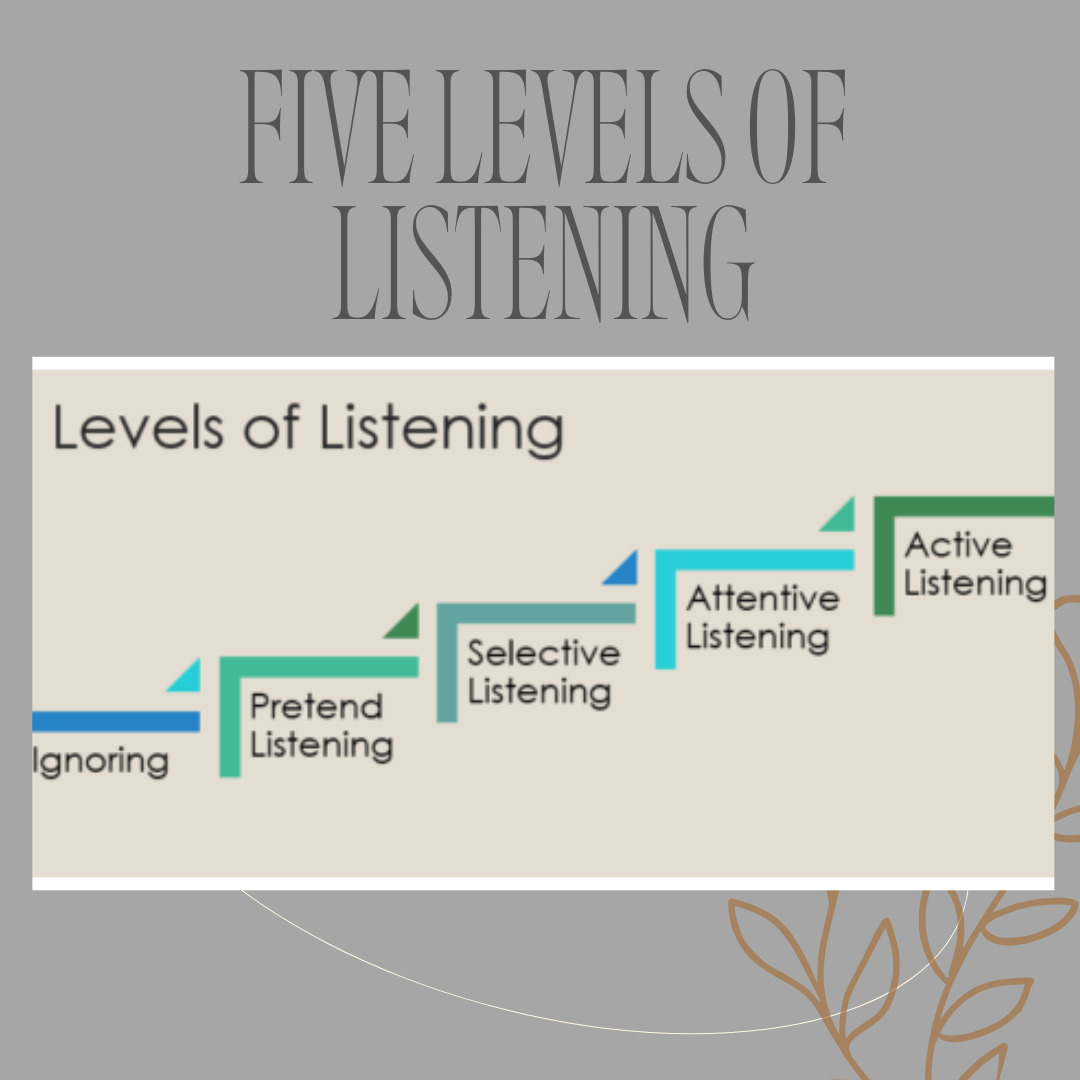The Five Levels of Listening help in determining how we listen.
When we think of listening, it is easy to say, ‘Oh, yeah. I’m listening.’ — without little thought to the process or if we are actually listening. I started thinking more about this when I watched a young mother with a child following her through the store. Each of her replies to his incessant chatter were:
“I’m listening.”
Was she really listening?
She was! It was more a matter of where on the scale she was listening.

The Five Levels of Listening indicates the level of true communication between speaker and listener. That simple. Stephen Covey examines this process of listening and effective communication in his book: The 7 Habits of Highly Effective People.

Level 1: Ignoring
First, this is the lowest level of listening. No effort is being given by the listener. There are many reasons why listening occurs at this level.
Distraction – Maybe the listener is busy. How many times have you been busy with something and then suddenly realized another person was talking to you? Or you were talking to someone only to realize they didn’t even realize you were there? Try calling the individual by name to get their attention.
Intentional ignoring – This happens, doesn’t it? Maybe you’ve fought with someone and they are simply not going to acknowledge you. Or the listener doesn’t want to acknowledge the information.
Physical restrictions – There could be a hearing problem. Or maybe the listener has earphones in.
There are many reasons why ignoring occurs.

Level 2: Pretend Listening
Second, this level is where the listener is giving an appearance of listening but not really engaged. This is the level of the example at the beginning of this article.
My favorite example happened a few years ago. One of our teenage daughters called my husband. She started rambling about the details of a TV show she had just watched with a friend. She spoke loud enough that I could hear her comments and I smiled at her enthusiasm. However, soon, I heard my husband’s responses change from being engaged to clearly pretend listening. What was his response? “Uh-huh.” “Really?” “Good.” For several minutes, he repeated these three statements.
Pretend listening. He was disengaged because the information did not have value to him.

Level 3 – Selective Listening
Third, this is when we pay attention to people as long as we agree with them or if we are desirous to hear what they have to say. This is a bit different from pretend listening because the listener is paying attention enough to be able to re-engage in the conversation as it becomes interesting to them.
At this level, the listener will be quick to jump and interrupt the speaker to add something, change the topic or to simply finish the other person’s sentences.
The dangerous piece of the selective listening level is that it is easy to fall into the ignoring or pretend listening levels.
My mother often jokes that my father has selective listening. She could talk to him about something important to her like quilting or running an errand. He may not even acknowledge her, but when the topic is changed to something like going out to eat or making fudge, she immediately has his attention!

Level 4 – Attentive Listening
Fourth, this is usually the level that we tend to spend most of our time as listeners. This is our day-to-day life. The listener listens and evaluates the information determining if they agree or disagree with the information. This is the point that the listener is assessing the knowledge and how it applies to them.
Again, there is a word of caution at this level. If a listener determines that the information is not as important, they may fall from the attentive listening level to a lower level of listening.
Elevate your listening skills with these powerful resources! Explore tools, tips, and strategies to master all five levels of listening—from basic awareness to empathetic understanding. Perfect for leaders, educators, and anyone looking to communicate effectively. 🗣️✨


Level 5 -Active or Empathetic Listening
Fifth, this is the pinnacle of listening. The application of listening with intention is the foundation of empathetic listening. The listener is paying attention to the words, what it means to them and most importantly what it means to the speaker. The listener gives their full attention – completely focused on the speaker. This is where the old adage comes to play – walking in another’s shoes. The listener gives their whole self to the conversation – ears, heart and mind.
This is the hardest level of listening to achieve because it does require so much energy from the listener.
The levels of listening can motivate an individual to be a better learner. How? As you go throughout your day, look carefully at your conversations and see where you are on the scale. I did this yesterday. After a long meeting at work, I sat back and pondered, “What was my level of listening?” I quickly realized that the only level I had not exhibited during the 90 minute meeting was level 1 – ignoring. This is natural. But the goal should be to live at a higher level of listening – demonstrating to those around us that they are important.
Sources:
Covey, S. (1989). The 7 Habits of Highly Effective People.
Subscribe to our YouTube Channel by clicking here.








Comments are closed